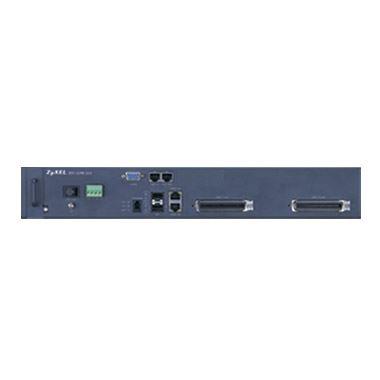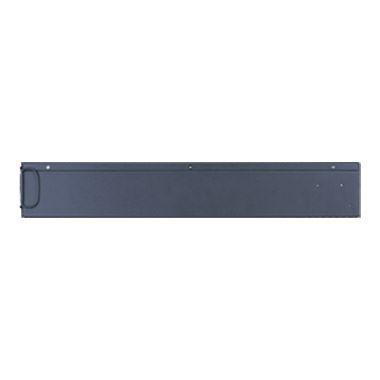IES-1248-51V
Remote-MSAN für ADSL- und VoIP-Dienste mit 48 Ports
Bereitstellung von Triple-Play-Diensten mit hohen Bandbreiten für Teilnehmer
Temperaturbeständiges Design und benutzerfreundliche Remote-Installation
Der ZyXEL IES-1248-51V ist für Betriebstemperaturen von -40° C bis 65° C ausgelegt. Damit werden verschiedene Umgebungsbedingungen für Fiber-to-the-Node und Fiber-to-the-Curb weltweit erfüllt. Eine entnehmbare Filterkassette, die gereinigt und wiederverwendet werden kann, sorgt für ein staubgeschütztes Design und macht ihn für den Einsatz im Freien geeignet.
Darüber hinaus wird die Drehgeschwindigkeit des Lüftermoduls automatisch je nach Systemtemperatur angepasst. Dadurch wird nicht nur die Lebensdauer des Moduls erhöht, sondern der Geräuschpegel gesenkt, was beim Einsatz des IES-1248-51V in einem Wohnviertel wichtig ist. Das Lüftermodul lässt sich im laufenden Betrieb austauschen. Damit werden die Wartungskosten im Einsatz gesenkt.
Komplette ADSL2+ Dienste
Die Teilnehmer erhalten mit dem IES-1248-51V ADSL2+ Konnektivität nach dem neuesten Stand der Technik. Die aktuellsten Technologien wie verschiedene Fähigkeiten für Leitungscodierung, Power Spectral Mask Fitting, Dual Latency Path Selection, Loop Diagnostic und Energie-Management, Seamless Rate Adaptation (SRA) sowie Impulse Noise Protection (INP) werden alle unterstützt. Durch bis zu 24 Mbit/s (im Downstream) und 2,3 Mbit/s (im Upstream) pro Port werden bandbreitenintensive Dienste wie Streaming Video, Online-Spiele und IP TV auf einfache Weise verfügbar. Auch ADSL2+ Port-Bonding steht Teilnehmern zur Verfügung, die noch mehr Bandbreite benötigen oder bei denen die Loop-Länge mehr als 1500 m beträgt.
Integriertes VoIP Media Gateway
In den IES-1248-51V ist ein POTS-Splitter eingebaut. Er kann als Media Gateway eines paketbasierten Sprachnetzwerks fungieren. Durch die Kommunikation mit dem Softswitch oder Media Gateway Controller digitalisiert und verkapselt der IES-1248-51V die POTS-Sprachdaten in VoIP-Pakete und liefert sie an das IP-Netzwerk mit höherer Priorität in SIP- oder H.248 Signalprotokollen. Telekommunikationsanbieter sind damit in der Lage, den OAM&P-Aufwand beizubehalten und Voice-over-broadband (VoBB) Dienste anzubieten, ohne das Netzwerk auf Kundenseite ändern zu müssen.
Hochentwickelte Funktionen für Triple-Play-Dienste
Der IES-1248-51V ist mit umfassenden ATM- und Ethernet-QoS-, sowie verschiedenen IP-QoS-Features ausgerüstet (Paket-Klassifizierung/?bertragungsratenbegrenzung/Queue Scheduling). Das nahtlose QoS-Mapping ermöglicht nicht nur ein konsistentes sowie adäquates Handling von Datenpaketen, sondern auch die Erfüllung von Anforderungen durch Triple-Play-Dienste.
Es werden 512 Multicast-Gruppen mit jeweils 50 Mitgliedern unterstützt. In einer Sekunde können mindestens 30 Multicast IGMP Join-/Leave-Requests verarbeitet werden und die maximale Kanalverarbeitungszeit liegt unter 250 ms. Aus Sicherheitsgründen wurden Funktionen wie MAC Address Spoofing, Broadcast Storm Prevention, MAC Count Limiting und Paketfilterung integriert. Mit diesen Funktionen können Telekommunikationsanbieter Triple-Play-Dienste wie High-Speed Internetzugang, VoIP, Near-Video-on-Demand, Broadcast TV und TV-on-Demand einfach bereitstellen.
Network Interface
IEEE 802.3u 100BASE-Tx
IEEE 802.3ab 1000BASE-T
IEEE 802.3z 1000BASE-ZX/LHX/LX/SX
SFP mini GBIC
ADSL/ADSL2/ADSL2+ Interface
G.992.1 Annex A
G.992.3 Annex A, Annex L, Annex M
G.992.5 Annex A, Annex M
G.994.1 G.hs
G.992.3, G.992.5, G.997.1 Spectral Mask
G.992.3 and G. 992.5 ATM Transmission Convergence (ATM-TC) function
EOC defined in ITU-T G.992.3 and ITU-T G.997.1
Latency path function specified in ITU-T G.992.3 and G.992.5
Loop diagnostic function (SELT & DELT) specified in ITUT G.992.3 and G.992.5
Power management capability specified in ITU-T G.992.3 and G.992.5
Seamless Rate Adaptation (SRA) on-line configuration
Impulse Noise protection (INP) specified in ITU-T G.992.3 and G.992.5
ATM Functionality
8 VPC/VCC per DSL port
UBR, CBR, rt-VBR, nrt-VBR, ABR QoS Mechanisms
ATM Forum TM 4.0 peak cell rate traffic parameter
Downstream traffic shaping per ATM PVC
ATM F5 OAM cells for End-to-End Loop back test (ITU-T Rec. I.610)
G.998.1 multi-pair ATM bonding (*)
Support 64k PVC
L2 Bridging
802.1d and 802.w RSTP
Max MAC address per system : 14K
Max MAC address per port : 128
Auto MAC address learning
Block duplicate MAC address (MAC address spoofing)
Configurable MAC aging-out time
Limiting number of MACs per port
Static MAC address filtering
User Isolation (per system)
VLAN & VLAN Bridge Functions
Provide 1024 configurable VLANs with 4K VLAN tagging
The VLAN tagging complies with IEEE 802.1Q
GVRP function
128 VLAN +MAC per DSL port
VLAN bridge function (multiple PVCs to one VLAN)
VLAN cross connect (PVC to VLAN one to one mapping)
VLAN trunking (single PVC join multiple VLAN)
IEEE 802.1ad provider bridge (Q-in-Q)
QoS
Configurable IEEE 802.1p priority queue function and support 4 levels
Configurable mapping function between ATM PVC and 802.1p priority queue
TOS/DSCP to IEEE 802.1p p-bit mapping in the network interface
Upstream rate limiting by ACL in the DSL port
Strict Priority queuing in the network interface
IP Functionality
RFC2684 bridged mode multicast service
RFC2684 routing mote support
ICMP function support
PPPoA forwarding
DHCP relay agent option 82 (circuit ID and Remote ID)
DHCP snooping
IEEE 802.1x
IPSec/L2TP/PPTP VPN pass-through function
RFC2516 PPPoE packet forwarding function
Packet Filtering
Discard downstream broadcast
Control downstream broadcast
Source MAC address filtering (pass or deny)
PPPoE filtering
Layer 3 filtering based on IP header : Src addresses, dest addresses, protocol ID, UDP / TCP port number
ARP broadcast Filtering
Downstream broadcast enable/disable ( per-VLAN, per-port)
NetBIOS filtering
DHCP broadcast filtering
IGMP filtering
Block BPDU/ARP/LACP/GMRP/upstream pause frame on DSL side
Multicast Capability
Internet Group Management Protocol (IGMP) version 2 specified in RFC2236
VLAN-aware IGMP snooping/IGMP proxy
Multicast VLAN support
512 multicast groups
50 copies for each multicast group
Number of zap per second per system : >30
Expedite leave : < 250 ms
Multicast bandwidth control
IGMP membership report
Static multicast forwarding
Multicast address filtering profile
Load protection for IGMP
VoIP Services
SIP v2 singling protocol and H.248 version 2(*)
Voice CODEC : G.711 a/µ, G.726, G.729 a/b G.723.1
Configurable jitter buffer
Generation of dial tone, second dial tone, ringing tone (ring-back tone), busy tone, off-hook warning tone
DTMF detection and generation (bi-directional)
In-Band and Out-of-Band (RFC 2833), (SIP INFO)
FAX/Modem pass through (T.38) via RTP
call waiting, call hold, call transfer
Local dial available(*)
MLT (Metallic loop testing for subscriber lines) ??GR909 and GR844
Management
Local management through a craft terminal
In-band IP interface for managing the Network
SNMP (Simple Network Management Protocol) v1.0 & v2c (RFC1157)
The management activities can be performed by SNMP operations
Support SNMP MIB(s)
standard SNMP traps so that these traps can be reported to other NMSs
Centralized Management Software ??NetAtlas Access supporting
MIB Support
RFC1213 SNMP MIB II
RFC1493 Bridge MIB
RFC1643 Ethernet MIB
RFC2674 Q MIB
RFC2662 ADSL line MIB
ADSLx line MIB
RFC1757 RMON MIB, group 1,2,3,9
ZyXEL proprietary MIB
Hardware Specifications
Two TELCO-50 connectors for 48-port ADSL/ADSL2/ADSL2+
One mini RJ11 console port for local management
Two 100Base-TX/1000Base-T or two mini GBIC for uplink/subtending
One DB9 for 3 in and 1 out alarm contact
Hot-swappable fan module
DC Input connector
One power switch
Two RJ-45 ports for loop test out and test in functionality
Physical Specifications
19??and 23??Rack-mountable
Dimensions: 439.8 (W) x 251 (D) x 66 (H) mm
Swappable FAN module
Built-in splitter
Side-slip dust filter
Weight: 8.2 Kg
Environmental Specifications
Operating Temperature: -40°C ~ 65°C
Storage Temperature: -40°C ~ 70°C
Operating Humidity: 10% ~ 95% (noncondensing)
Storage Humidity: 5% ~ 95% (non-condensing)




